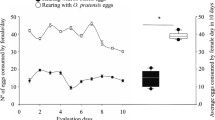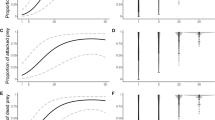It is believed that habitat heterogeneity can change the extent of predator-prey interactions. Therefore, in this study we examined the effect of habitat heterogeneity (characterized here as an addition of refuge) on D. ater predation on M. domestica. Predation of D. ater on M. domestica larvae was carried out in experimental habitats with and without refuge, and examined at different prey densities. The number of prey eaten by beetles over 24 h of predator-prey interaction was recorded, and we investigated the strength of interaction between prey and predator in both experimental habitats by determining predator functional response. The mean number of prey eaten by beetles in the presence of refuge was significantly higher than in the absence of refuge. Females had greater weight gains than males. Logistic regression analyses revealed the type II functional response for both experimental habitats, even though data did not fit well into the random predator model. Results suggest that the addition of refuge in fact enhanced predation, as prey consumption increased in the presence of refuge. Predators kept in the presence of refuge also consumed more prey at high prey densities. Thus, we concluded that the addition of refuge was an important component mediating D. ater-M. domestica population interactions. Refuge actually acted as a refuge for predators from prey, since prey behaviors detrimental to predators were reduced in this case.

Similar content being viewed by others
REFERENCES
Alto, B. W., Griswold, M. W., and Lounibos, L. P. (2005). Habitat complexity and sex-dependent predation of mosquito larvae in containers. Oecologia 146: 300–310.
Axtell R. C., and Arends, J. J. (1990). Ecology and management of arthropod pests of poultry. Annu. Rev. Entomol. 35:101–126.
Bai, M. G., and Mahadevappa, L. (1996). Management of Dermestes ater DeGeer (Coleoptera, Dermestidae) and Labia arachidis (Yersin) (Dermaptera, Labiidae) on silkworm Bombyx mori L. Pest. Manag. Econ. Zool. 2: 49–51.
Bowman, D. D. (1995). Parasitology for Veterinarians. WB Saunders Company, Philadelphia.
Clark, T. L., and Messina, F. J. (1998) Foraging behavior of lacewing larvae (Neuroptera: Chrysopidae) on plants with divergent architectures. J. Insect Behav. 11: 303–317.
Cloud, J. A., and Collison, C. H. (1986). Comparison of various poultry house litter components for hide beetle (Dermestes maculatus DeGeer) larval development in the laboratory. Poultry Sci. 65: 1911–1914.
Coen, L. D., Heck, K. L., and Abele, L. G. (1981). Experiments on competition and predation among shrimps of seagrass meadows. Ecology 62: 1484–1493.
Cunha, C. L., and Lomônaco, C. (1996). Monitorização de inpacto ambiental provocado por dispersão de moscas em bairros adjacentes a uma granja avícola. An. Soc. Entomol. Brasil 25: 1–12.
De Clercq, P., Mohaghegh, J., and Tirry, L. (2000). Effect of host plant on the functional response of the predator Podisus nigrispinus (Heteroptera: Pentatomidae). Biol. Control 18: 65–70.
Ferreira, M. J. M., and Lacerda, P. V. (1993). Muscóides sinantrópicos associados ao lixo urbano em Goiânia, GO. Rev. Brasil. Zool. 10: 185–195.
Finke, D. L., and Denno, R. F. (2002). Intraguild predation diminished in complex-structured vegetation: Implications for prey suppression. Ecology 83: 643–652.
Flynn, A. J., and Ritz, D. A. (1999). Effect of habitat complexity and predatory style on the capture success of fish feeding on aggregated prey. J. Mar. Biol. Ass. UK 79: 487–494.
Gause, G. F. (1934). The struggle for existence. Dover (Reprinted 1971), New York.
Harwood, R. F., and James, M. T. (1979). Entomology in Human and Animal Health. Macmillan Publishing Cos. Inc., New York.
Hoddle, M. S. (2003) The effect of prey species and environmental complexity on the functional response of Franklinothrips orizabensis: A test of the fractal foraging model. Ecol. Entomol. 28: 309–318.
Hohberg, K., and Traunspurger, W. (2005). Predator-prey interaction in soil food web: Functional response, size-dependent foraging efficiency, and the influence of soil texture. Biol. Fert. Soils 41: 419–427.
Holling, C. S. (1959). The components of predation as revealed by a study of small mammal predation of the European sawfly. Can. Entomol. 91: 293–320.
James, P. L., and Heck, K. L. (1994). The effects of habitat complexity and light intensity on ambush predators within a simulated seagrass habitat. J. Exp. Mar. Biol. Ecol. 176: 187–200.
Juliano, S. A. (2001). Nonlinear curve fitting: Predation and functional response curves. In Scheiner, S. M., and Gurevitch, J. (eds.), Design and Analysis of Ecological Experiments. Oxford University Press, New York, pp. 178–196.
Kaiser, H. (1983). Small scale spatial heterogeneity influences predation success in an unexpected way: Model experiments on the functional response of predatory mites (Acarina). Oecologia 56: 249–256.
Kumar, P., Jayaprakas, C. A., Singh, B. D., and Sen-Gupta, K. (1988). Studies on the biology of Dermestes ater (Coleoptera, Dermestidae)—a pest of silkworm pupae and adults. Curr. Sci. 57: 1253.
Legrand, A., and Barbosa, P. (2003). Plant morphological complexity impacts foraging efficiency of adult Coccinella septempunctata L. (Coleoptera: Coccinellidae). Environ. Entomol. 32: 1219–1226.
Levine, O. S., and Levine, M. M. (1991). Houseflies (Musca domestica) as mechanical vectors of Shigellosis. Rev. Infec. Dis. 13: 688–696.
Li, H., and Reynolds, J. F. (1994). A simulation experiment to quantify spatial heterogeneity in categorical maps. Ecology 75: 2446–2455.
Lomônaco, C., and Prado, A. P. (1994). Estrutura comunitária e dinâmica populacional da fauna de dípteros e seus inimigos naturais em granjas avícolas. An. Soc. Entomol. Brasil 23: 71–80.
Manatunge, J., Asaeda, T., and Priyadarshana, T. (2000). The influence of structural complexity on fish-zooplankton interactions: A study using artificial submerged macrophytes. Env. Biol. Fish. 58: 425–438.
May, R. M. (1978). Host-parasitoid systems in patchy environments: A phenomenological model. J. Anim. Ecol. 47: 833–843.
McNair, J. N. (1986) The effects of refuges on predator-prey interactions: A reconsideration. Theor. Popul. Biol. 29: 38–63.
Menezes, L. C. C. R., Rossi, M. N., and Reigada, C. (2005). Consequences of refuge for the functional response of Dermestes ater (Coleoptera: Dermestidae) to Musca domestica (Diptera: Muscidae). Popul. Ecol. 47: 213–219.
Messina, F. J., and Hanks, J. B. (1998). Host plant alters the shape of the functional response of an aphid predator (Coleoptera: Coccinelidae). Environ. Entomol. 27: 1196–1202.
Murdoch, W. W., and Briggs, C. J. (1996). Theory for biological control: Recent developments. Ecology 77: 2001–2013.
Poggiale, J. C., and Auger, P. (2004). Impact of spatial heterogeneity on a predator-prey system dynamics. C. R. Biol. 327: 1058–1063.
Ranta, E., Lundberg, P., and Kaitala, V. (2006). Ecology of Populations: Ecology, Biodiversity and Conservation. Cambridge University Press, UK.
Roda, A., Nyrop, J., Dicke, M., and English-Loeb, G. (2000). Trichomes and spider-mite webbing protect predatory mite eggs from intraguild predation. Oecologia 125: 428–435.
Rogers, D. (1972). Random search and insect population models. J. Anim. Ecol. 41: 369–383.
Royama, T. (1971). A comparative study of models for predation and parasitism. Res. Popul. Ecol. Suppl. 1: 1–91.
SAS (2001). SAS/STAT Software; version 8.2. SAS Institute, Cary, North Carolina.
Savage, C. E., and Jones, R. C. (2003). The survival of avian reoviruses on materials associated with the poultry house environment. Avian. Pathol. 32: 419–425.
Savino, J. F., and Stein, R. A. (1982). Predator-prey interaction between largemouth bass and bluegills as influenced by simulated, submersed vegetation. Trans. Am. Fish. Soc. 111: 255–266.
Smith, K. G. V. (1986). A Manual of Forensic Entomology. University Printing House, Oxford.
Spitzer, P. M., Mattila, J., and Heck, K. L. (2000). The effects of vegetation density on the relative growth rates of juvenile pinfish, Lagodon rhomboides (Linneaus), in Big Lagoon, Florida. J. Exp. Mar. Biol. Ecol. 244: 67–86.
Trexler, J. C., McCulloch, C. E. and Travis, J. (1988). How can the functional response best be determined? Oecologia 76: 206–214.
Turchin, P. (2003). Complex population dynamics: A theoretical empirical synthesis. Monographs in Population Biology (35), Princeton University Press, Princeton.
Veer, V., Negi, B. K., and Rao, K. M. (1996). Dermestid beetles and some other insect pests associated with stored silkworm cocoons in India, including a world list of dermestid species found attacking this commodity. J. Stored. Prod. Res. 32: 69–89.
Wellnitz, T., and Poff, N. L. (2001). Functional redundancy in heterogeneous environments: Implications for conservation. Ecol. Lett. 4: 177–179.
Wise, D. H. (1993). Spiders in Ecological Webs. Cambridge University Press, Cambridge.
Yamamura, K. (1998). Stabilization effects of spatial aggregation of vectors in plant disease systems. Res. Popul. Ecol. 40: 227–238.
Zar, J. H. (1999). Biostatistical Analysis. Prentice Hall, Upper Saddle River, New Jersey.
ACKNOWLEDGMENTS
We thank the PhD student Carolina Reigada and Professor James Welsh for providing statistical advice and for revising the text of the manuscript, respectively. L. C. C. R. Menezes, and M. N. Rossi are particularly grateful to Fapesp (Fundação de Amparo à Pesquisa do Estado de São Paulo) for financial support.
Author information
Authors and Affiliations
Corresponding author
Rights and permissions
About this article
Cite this article
Menezes, L.C.C.R., Rossi, M.N. & Godoy, W.A.C. The Effect of Refuge on Dermestes ater (Coleoptera: Dermestidae) Predation on Musca domestica (Diptera: Muscidae): Refuge for Prey or the Predator?. J Insect Behav 19, 717–729 (2006). https://doi.org/10.1007/s10905-006-9056-x
Published:
Issue Date:
DOI: https://doi.org/10.1007/s10905-006-9056-x




